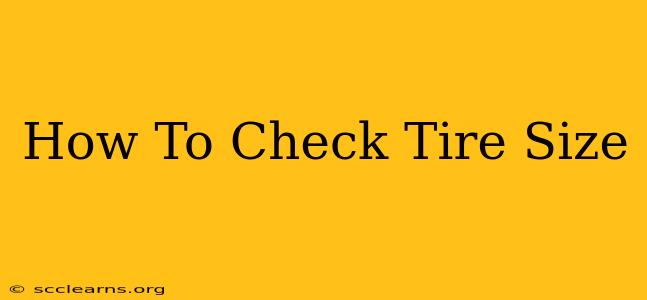Knowing your tire size is crucial for safety and proper vehicle maintenance. Incorrect tires can impact your vehicle's handling, fuel efficiency, and even its lifespan. Fortunately, checking your tire size is quick and easy. This guide will walk you through several methods to find this vital information.
Where to Find Your Tire Size Information
There are three primary places to locate your tire size:
1. The Tire Sidewall
The most straightforward method is to look directly at your tires. The tire sidewall (the vertical surface of the tire) displays a series of numbers and letters. This is your tire's size designation. For example, you might see something like P215/65R15. Let's break down what these numbers mean:
- P: This indicates the tire is for a passenger vehicle. You might also see LT (Light Truck) or ST (Special Trailer).
- 215: This is the tire's width in millimeters.
- 65: This is the aspect ratio, representing the tire's height as a percentage of its width.
- R: This signifies that the tire has a radial construction (most modern tires are radial).
- 15: This is the wheel diameter in inches.
2. The Driver's Side Doorjamb
Your vehicle's manufacturer provides this information as a sticker located on the driver's side doorjamb. This sticker usually contains various vehicle specifications, including your recommended tire size. This is a great backup method if you can't easily read the information on the tire itself. Check this sticker for the most accurate information, as it specifies the manufacturer's recommendation.
3. Your Vehicle's Owner's Manual
Your owner's manual contains a wealth of information about your vehicle, including the recommended tire size. If you still can’t find the information on the tire or the doorjamb sticker, consult your owner's manual.
Understanding Tire Size Codes
While the numbers and letters on your tire sidewall might seem confusing at first, understanding the components allows you to easily interpret the information:
- Width: This is the tire's tread width in millimeters. A wider tire generally provides better grip and stability.
- Aspect Ratio: This is the ratio of the tire's sidewall height to its width. A lower aspect ratio indicates a shorter sidewall and a firmer, sportier ride. A higher aspect ratio provides a more comfortable ride but may compromise handling.
- Construction: This indicates the tire's construction type (Radial is the most common).
- Wheel Diameter: This is the diameter of the wheel rim in inches, which the tire fits onto.
Why Knowing Your Tire Size Matters
Knowing your tire size is critical for several reasons:
- Safety: Using the incorrect tire size can significantly impact your vehicle's handling and braking performance, compromising safety.
- Fuel Efficiency: Incorrect tire sizes can negatively impact fuel economy.
- Vehicle Damage: Using incorrect tires can cause damage to your vehicle's suspension, wheel bearings and other components.
- Warranty: Using non-recommended tires might void your vehicle's warranty.
By following these simple steps, you can quickly and easily determine your tire size, ensuring your vehicle's optimal performance and your safety on the road. Remember to always refer to your owner's manual or the sticker on your driver's side doorjamb for the manufacturer's recommended tire size.

